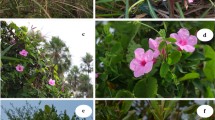Abstract
Previous anatomical studies have been restricted to the foliar aspects of Pilocarpus. However, no anatomical studies analyzing the foliar aspects of Pilocarpus in relation to related genera have been carried out. Therefore, the aim of this study was to identify characters for future taxonomic and phylogenetic studies in Rutaceae, particularly in Pilocarpus, and to discuss the characteristics associated with the simple or compound leaf condition for the group. The petiole and the leaf blade of 14 neotropical Rutaceae species were analyzed, and the following characteristics were observed in all leaves studied: stomata on both surfaces; secretory cavities, including mesophyll type; camptodromous–brochidodromous venation pattern; and free vascular cylinder in the basal region of the petiole. Additional promising characters were identified for future taxonomic and phylogenetic studies in the Rutaceae family, especially for the Pilocarpus genera.







Similar content being viewed by others
References
Bayer RJ, Mabberley DJ, Morton C, Miller CH, Sharma IK, Pfeil BE, Rich S, Hitchcock R, Sykes S (2009) A molecular phylogeny of the orange subfamily (Rutaceae: Aurantioideae) using nine cpDNA sequences. Am J Bot 96:668–685
But PP-H, Poon AW-S, Shaw P-C, Simmons MP, Greger H (2009) Contribution of molecular cladistics to the taxonomy of Rutaceae in China. J Syst Evol 47:144–150
Chase MW, Morton SM, Kallunki JA (1999) Phylogenetic relationships of Rutaceae: a cladistic analysis of the subfamilies using evidence from rbcL and atpB sequence variations. Am J Bot 86:1191–1199
Corazza-Nunes MJ, Novelli VM, Moreira ALOR, Nunes WMC, Carvalho SA, Machado MA (2006) The phylogeny of Rutaceae: contributions from molecular systematics. In: Sharma AK, Sharma A (eds) Plant genome: biodiversity and evolution, vol. 1, part C: Phanerogams (angiosperm-dicotyledons). Science Publishers, Enfield, NH, pp 331–360
Cronquist A (1981) An integrated system of classification of flowering plants. Columbia University Press, New York
Cronquist A (1988) The evolution and classification of flowering plants, 2nd edn. The New York Botanical Garden, New York
Duval A (1903) Les jaborandis. Bull Sci Pharm 5:41–109
Franklin G (1945) Preparation of thin sections of synthetic resins and wood–resin composites and a new macerating method for wood. Nature 155(39):51
Gallardo LH, Jiménez ME (2002) Anatomía foliar de Pilocarpus goudotianus Tul. (Rutaceae). Caldasia 24:269–275
Groppo M, Pirani JR, Salatino MLF, Blanco SR (2008) Phylogeny of Rutaceae based on two noncoding regions from cpDNA. Am J Bot 95:985–1005
Hickey LJ, Wolfe JA (1975) The bases of angiosperm phylogeny: vegetative morphology. Ann Missouri Bot Gard 62:538–590
Johansen DA (1940) Plant microtechnique. McGraw-Hill, New York
Kaastra RC (1982) Pilocarpinae (Rutaceae). Flora Neotropica Monogr. 33. The New York Botanical Garden, New York
Kraus JE, Sousa HC, Rezende MH, Castro NM, Vecchi C, Luque R (1998) Astra blue and basic fuchsin double staining of plant materials. Biotech Histochem 73:235–243
Liu W, Hu Z (1998) Comparative anatomy of secretory cavities in leaves of the Rutaceae in China. Acta Phytotax Sin 36(2):119–127
Marquete O (1981) Anatomia e vascularização foliar e floral de Pilocarpus organensis Occhioni and Rizzini (Rutaceae). Arq Jard Bot Rio J 25:117–159
Metcalfe C, Chalk L (1950) Anatomy of the dicotyledons, vol. II. Clarendon Press, Oxford
Metcalfe C, Chalk L (1979) Anatomy of the dicotyledons: leaves, stem and wood in relation to taxonomy with notes on economic uses, 2nd edn, vol. 1. Clarendon Press, Oxford
Oliveira PD (2007) Filogenética de Pilocarpinae (Rutaceae). Universidade de São Paulo, São Paulo
Pan AD (2010) Rutaceae leaf fossils from the Late Oligocene (27.23 Ma) Guang River flora of northwestern Ethiopia. Rev Palaeobot Palynol 159:188–194
Pirani JR (1999) Estudos taxonômicos em Rutaceae: revisão de Helietta e Balfourodendron (Pteleinae), análise cladística de Pteleinae, sinopse de Rutaceae no Brasil. Universidade de São Paulo, São Paulo
Salvo G, Bacchetta G, Ghahremaninejad F, Conti E (2008) Phylogenetic relationships of Ruteae (Rutaceae): new evidence from the chloroplast genome and comparisons with non-molecular data. Mol Phyl Evol 49(3):736–748
Samuel R, Ehrendorfer D, Chase MW, Greger H (2001) Phylogenetic analyses of Aurantioideae (Rutaceae) based on non-coding plastid DNA sequences and phytochemical features. Plant Biol 3:77–87
Scholz H (1964) Rutales. In: Melchior H, Wedermann E (eds) A. Engler’s Syllabus der Pflanzenfamilien, 12th edn, vol. 2. Bornträger, Berlin, pp 262–277
Scott KD, McIntyre CL, Playford J (2000) Molecular analyses suggest a need for a significant rearrangement of Rutaceae subfamilies and a minor reassessment of species relationships within Flindersia. Pl Syst Evol 223:15–27
Silveira M (1989) Preparação de amostras biológicas para Microscopia eletrônica de varredura. In: de Souza W (ed) Manual sobre técnicas básicas em microscopia eletrônica, vol. 1. Universidade de São Paulo, São Paulo, pp 71–79
Skorupa LA (1996) Revisão taxonômica de Pilocarpus Vahl (Rutaceae). Doctoral thesis. University of São Paulo, Brazil
Skorupa LA, Pirani JR (2004) A new species of Pilocarpus (Rutaceae) from northern Brazil. Brittonia 56:147–150
Solereder H (1908) Systematic anatomy of dicotyledons. Clarendon, Oxford
Solís SM (1997) Estudios anatómicos de domacios foliares en tres especies de la familia Rutaceae. Bonplandia 9:295–303
Spegazzini ED, Castro MT, Rossi J, Carpano SM, Nájera TN (2002) Micrografía foliar cuali-cuantitativa de las especies de Pilocarpus (Rutaceae): P. jaborandi Holmes, P. microphyllus Stapf exwardleworth y P. pennatifolius Lem. Dominguesia 18:5–16
Strittmater CGD (1973) Nueva Técnica de Diafanización. Bol Soc Argent Bot 15:126–129
Acknowledgments
The authors thank the CNPq (Conselho Nacional de Desenvolvimento Científico e Tecnológico) and FAPESP (Fundação de Amparo a Pesquisa do Estado de São Paulo) for its financial support. Our thanks also go to Dr. J.R. Pirani for suggestions during the development of the study.
Author information
Authors and Affiliations
Corresponding author
Rights and permissions
About this article
Cite this article
Muntoreanu, T.G., da Silva Cruz, R. & Melo-de-Pinna, G.F. Comparative leaf anatomy and morphology of some neotropical Rutaceae: Pilocarpus Vahl and related genera. Plant Syst Evol 296, 87–99 (2011). https://doi.org/10.1007/s00606-011-0478-3
Received:
Accepted:
Published:
Issue Date:
DOI: https://doi.org/10.1007/s00606-011-0478-3




